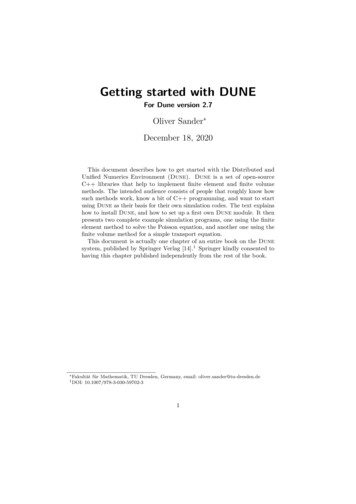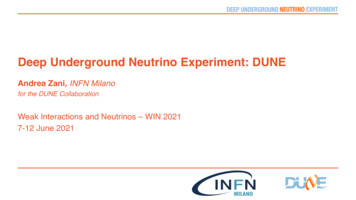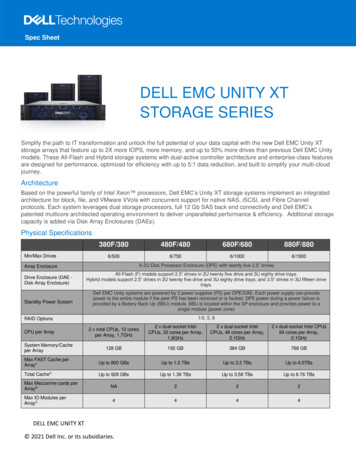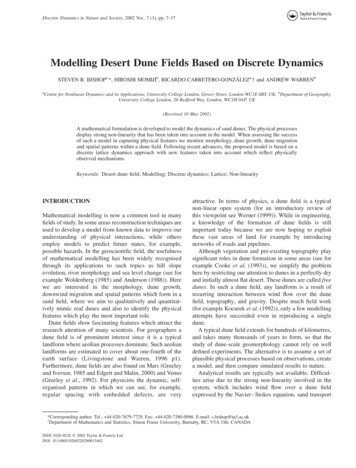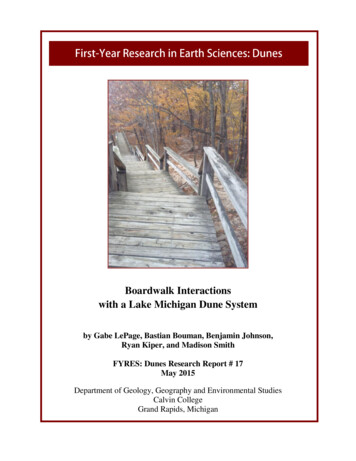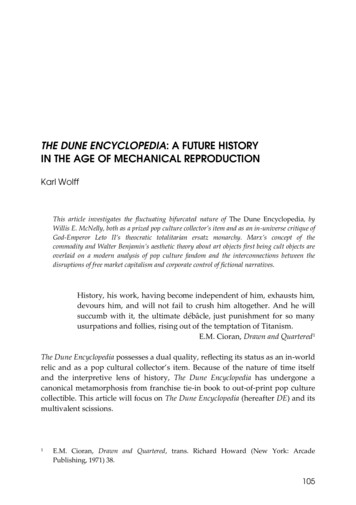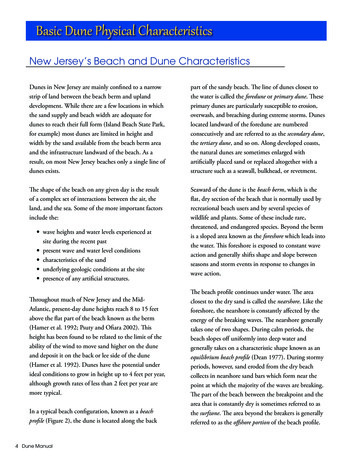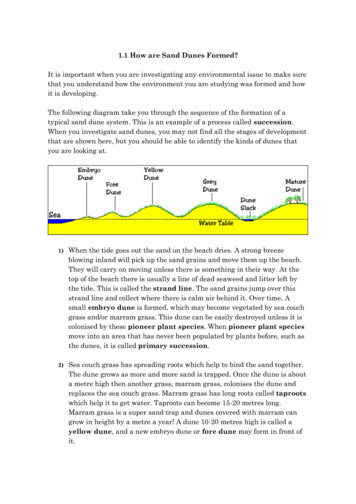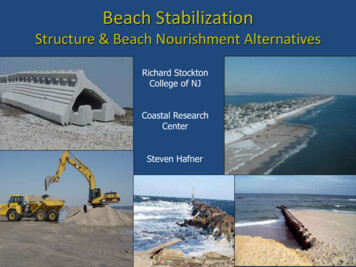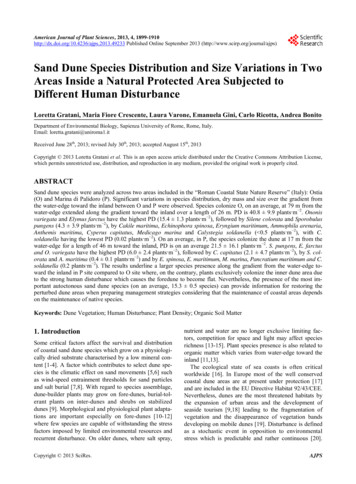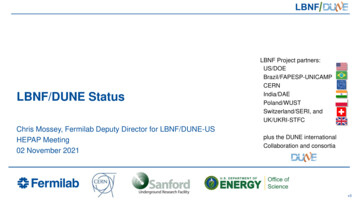
Transcription
LBNF/DUNE StatusChris Mossey, Fermilab Deputy Director for LBNF/DUNE-USHEPAP Meeting02 November 2021LBNF Project oland/WUSTSwitzerland/SERI, andUK/UKRI-STFCplus the DUNE internationalCollaboration and consortiav3
Outline P5 Background Project Scope DUNE Collaboration CD-1R Reaffirmation review Project Tailoring Strategy Project Status- Far Site- Near Site Summary202 Nov 2021C. J. Mossey LBNF/DUNE Status Report to the HEPAP
The 2014 US Particle Physics Project Prioritization Panel (P5) endorsed aglobal particle physics program Build a world-class neutrino program Host it as a global project Upgrade Fermilab accelerator complex to provide 1 MW proton beamRecommendation 13: Form a new international collaboration to design and execute a highly capable LongBaseline Neutrino Facility (LBNF) hosted by the U.S. To proceed, a project plan and identified resources mustexist to meet the minimum requirements in the text. LBNF is the highest priority large project in its timeframe.Recommendation 14: Upgrade the Fermilab proton accelerator complex to produce higher intensitybeams. R&D for the Proton Improvement Plan II (PIP-II) should proceed immediately, followed by construction,to provide proton beams of 1 MW by the time of first operation of the new long-baseline neutrino facility.The US neutrino program is supported by theEuropean Strategy302 Nov 2021C. J. Mossey LBNF/DUNE Status Report to the HEPAP
The 2014 US Particle Physics Project Prioritization Panel (P5) endorsed aglobal particle physics program Build a world-class neutrino program Host it as a global project Upgrade Fermilab accelerator complex to provide 1 MW proton beamRecommendation 13: Form a new international collaboration to design and execute a highly capable LongBaseline Neutrino Facility (LBNF) hosted by the U.S. To proceed, a project plan and identified resources mustexist to meet the minimum requirements in the text. LBNF is the highest priority large project in its timeframe.Recommendation 14: Upgrade the Fermilab proton accelerator complex to produce higher intensitybeams. R&D for the Proton Improvement Plan II (PIP-II) should proceed immediately, followed by construction,to provide proton beams of 1 MW by the time of first operation of the new long-baseline neutrino facility.The US neutrino program is supported by theEuropean Strategy402 Nov 2021C. J. Mossey LBNF/DUNE Status Report to the HEPAP
PIP-II / LBNF / DUNE delivers Powerful proton beams (PIP-II) 1.2 MW upgradable to multi-MW in energy range of 60-120 GeV to enable world’s most intense neutrino beam Dual-site detector facilities (LBNF) Deep underground caverns (1.5 km) to support 4 x 17 kt liquid argon volume detectors A long baseline (1300 km) neutrino beam, with wideband capability Deep Underground Neutrino Experiment (DUNE) The next-generation neutrino experimentMassive fardetectorLAr TPCtechnologyDeepundergroundcavernsFacilities fornear and fardetectors1300 kmbaselineMulti-componentnear otonbeamWORLD’S MOST INTENSENEUTRINO BEAMLBNF and PIP-II will enable the United States to host the global high energy physics community to502 Nov 2021C. J. Mossey LBNF/DUNE Status Report to the HEPAPadvanceworld class science into the fundamental nature of matter
The LBNF/DUNE vision is achieved by a groundbreaking international partnershipPIP-II Long Baseline Neutrino Facility – facilities with partner in-kind contributions DUNE-US – U.S. contribution to the DUNE experiment International DUNE - International contributions to the DUNE experiment602 Nov 2021C. J. Mossey LBNF/DUNE Status Report to the HEPAP
The LBNF/DUNE vision is achieved by a groundbreaking international partnershipPIP-II Long Baseline Neutrino Facility – facilities with partner in-kind contributions DUNE-US – U.S. contribution to the DUNE experiment International DUNE - International contributions to the DUNE experiment702 Nov 2021LBNF and DUNE-US are one DOE O413.3B ProjectC. J. Mossey LBNF/DUNE Status Report to the HEPAP
The DUNE experiment is managed by the international DUNE CollaborationCollaboration statisticsDemographics (not including computing)- 1,427 collaborators, 48% U.S./52% non-US- Facility/Senior staff: 679- 218 institutions from 37 countries CERN- Post Docs: 253- Grad Students: 326- Engineers: 159DUNE will be the first internationally conceived and operated mega-science experiment807 Oct 2021LBNF/DUNE Update to FRA Boardhostedby the Department of Energy in the United States
CD-1R “Reaffirmation” Review The project’s estimated cost, with full underground facilities to support the near detector and 4 x 17kton far detector modules, an upgradeable 1.2MW beam, and U.S. contributions to supportDUNE’s near detector and the first two 17 kton far detector modules is 3B. This will require a DOE CD-1R reaffirmation review, which is being planned in the spring 2022timeframe to establish a new cost range. HEP provided updated annual funding guidance in August 2021 to support this plan. In close coordination with our international partners and DUNE collaboration leadership, the projecthas implemented the funding profile, with the following sequenced objectives:1.Construct Far Detector 1 and Far Detector 2 Enables start of supernova, proton decay, and atmospheric neutrinoscience – early 20292.Construct Primary and Neutrino Beamline Enables start of oscillation physics - 20313.Construct Near Detector Enables understanding of detector systematics for ultimate scienceobjectives – early 2032902 Nov 2021C. J. Mossey LBNF/DUNE Status Report to the HEPAPTechnically limited schedule, forexcavation (underway), cryostatassembly starting in 2024, and detectorinstallation starting in 2025Funding limited schedule. Beamlineand Near Detector construction can beaccelerated 2.5 to 3 years with higherpeaked funding profile.
Project Tailoring Strategy The project has implemented a “subproject” strategy that will allow portions of theoverall DOE project scope to be baselined as soon as technically ready.- This is a preferred “packaging approach” that DOE is increasingly requiring for complex“billion dollar” scale projects (including PIP-II)- Addresses the variation in maturity between different project elements – for example, FarSite conventional facilities are ready to baseline now, while other project elements (e.g.,near detector) are still maturing- The CD-2/3 DOE review for the excavation subproject is 10-12 January 2022. There are five subprojects planned:- Three at the far site: 1) Far Site Excavation, 2) Far Site Building & Site Infrastructure, and3) Far Detectors/Cryogenic Infrastructure- Two at the near site: 1) Conventional facilities & beamline and 2) Near Detector- See next slide for summary of subprojects and maturityFar SiteExcavationSubprojectDOE02 Nov2021C. J. Mossey LBNF/DUNE StatusReport CD-2/3to the HEPAP baseline review will be in January 202210
Subprojects Implementation, Maturity, and Baselining StrategySubprojFAR SITEAbbrevFSCF-EXCFar Site ConventionalFacilities - ExcavationFSCF-BSIFar Site ConventionalFacilities – Building & SiteInfrastructureFDCNEAR SITESubproject TitleNSCF BNDFar Detector 1,Far Detector 2 CryogenicsNear Site ConventionalFacilities BeamlineNear DetectorSubproject ScopeDesignMaturityAll Far Site (FS) conventional facilities (CF) reliability,pre-excavation, and excavation including all detector100%Construction Underway, 55% completecavernsAll Far Site (FS) conventional facilities (CF) supportinfrastructure100%Master contract, with not to exceed costs, in placeFar Detector 1 (FD1), Far Detector 2 (FD2), including90% (FD1)integration/installation, and all cryogenic infrastructure 30% (FD2)(C) and LAr fluids.25% (C)Proposals in hand for Phase 1 of main cryo systemAll Near Site (NS) conventional facilities (CF) includingbeamline facilities, detector cavern and support100% (CF)infrastructure; primary and neutrino beamline (B)67% (BL)Request for Proposals for CF under DOE reviewNear Detector (ND) including integration/installationand cryogenic systems30%ProposedCD-2 IPRScheduledJan 202220232022 or20232022 or20232023 to202502 Nov 2021C. J. Mossey LBNF/DUNE Status Report to the HEPAPSubprojectapproachallows the project to employ a “baseline when ready” strategy11
Project Status UpdateRoss shaft headframe02 Nov 122021Yates shaft headframeThe far site at Sanford Underground Research Facility (SURF) , Lead, SDC. J. Mossey LBNF/DUNE Status Report to the HEPAP
Project Status at the Far SiteConventional Facilities Construction Reliability Project upgrades to SURF1 – complete ( 41M). Significantinfrastructure upgrades, including refurbished shaft and new hoist system. Pre-excavation phase – complete ( 125M). Equipment and systems to moveexcavated rock from one mile underground to the surface and deposit in theOpen Cut.Depositing rock in Open Cut All construction work has completed on schedule and with low changeorder rate ( 6%) despite three-week SURF shutdown due to COVID.-Excavation phase – underway ( 200M). Construction of three DUNE cavernsand new ventilation shaft. Work started in April 2021; plan to finish April 2024.Contractor is performing very well. Ready to start installation of utility systems (HVAC, electrical, etc) assoon as excavation is completed in 2024; master contract is already inplace.1SURFDrilling holes for Rock Blast Sanford Underground Research Facility, Lead, SDWith completion of reliability and pre-excavation work and award of excavation contract,1307 Oct 2021to FRA BoardthelargestLBNF/DUNEfar siteUpdateprojectcost uncertainties have been largely eliminated
All Reliability Upgrade Projects were Completed in April 20211930-era Control System - Foot Pedals, Analog Gauges, and Hand Levers - replaced with state-of-the-art digital control system1402 Nov 2021C. J. Mossey LBNF/DUNE Status Report to the HEPAP
New Hoist Control SystemNew Hoist Control Center with FlatScreen Monitors and Joystick Controls1502 Nov 2021New Hoist Climate Control Cabs for cage and skip systemsC. J. Mossey LBNF/DUNE Status Report to the HEPAP
New Hoist Components – Motors and Brake ShoesNew 1,700HP AC Motors1602 Nov 2021C. J. Mossey LBNF/DUNE Status Report to the HEPAPNew Service Hoist Brake Shoes
Video courtesy of Matt Kapust, SDSTAPre-Excavation Work Completion - First Test of Rock Handling System – May 20211702 Nov 2021C. J. Mossey LBNF/DUNE Status Report to the HEPAP
Project Excavation ScopeGenerator Room1,200’ Raise BoreVent shaftExpanded DriftMaintenance ShopRoss Brow2 x Detector Caverns:475' L x 65' W x 92’ H145m L x 20m x 28m#6 Winze Dump1802 Nov 2021Concrete Supply ChamberC. J. Mossey LBNF/DUNE Status Report to the HEPAP1 x Central Utility Cavern (CUC):624' L x 64' W x 37’ H180m L x 20m W x 11m H
Overall ExcavationStatus as of 31 OctoberTemporaryRoss ShaftTotal Excavation Complete 9.8%Concrete BatchPlant LocationWest Access DriftExcavation Direction (Red Team)Excavation Direction (Blue Team)Excavation CompletedExcavation and Shotcrete CompleteConcrete CompleteRaise Bore100% Reaming Complete
Reaming of 1200’ Raise Bore Ventilation Shaft was completed on 4 October 20213650L Cavern1200’ raise boreventilation shaftPhoto of start of reaming at 4850L – 13 July 20212012’ reamer head at breakthrough at 3650L Cavern – 4 Oct 202102 Nov 2021C. J. Mossey LBNF/DUNE Status Report to the HEPAPCompletionof excavationfor the raise bore retires most significant excavation risk
Far Site Excavation ProcessSetting out the Blasting Pattern2102 Nov 2021C. J. Mossey LBNF/DUNE Status Report to the HEPAPDrilling Charge Holes in the 4850-81 Face
Far Site Excavation ProcessMoving “muck” to the ore bin, to be loaded in skip and moved to surface,crushed, and conveyed to the Open Cut2202 Nov 2021C. J. Mossey LBNF/DUNE Status Report to the HEPAPInstalling rock bolts and welded-wirefabric for ground control
Excavation Status PhotosSetting Up the Robotic Shotcrete Machine2302 Nov 2021Surveyor mapping the 4850-13S HeadingC. J. Mossey LBNF/DUNE Status Report to the HEPAPPermanent Concrete Batch Plant (4850-47)
Completion of Maintenance Chamber allows LargerEquipment for Main Cavern Excavation to BeginMovement UndergroundSandvik 422i Jumbo on surface2402 Nov 2021Sandvik 422i Jumbo being reassembled at 4850L in new maintenance cavernC. J. Mossey LBNF/DUNE Status Report to the HEPAP
Project Status at Far Site Cryostats and Cryogenics Infrastructure Initial proposals (“phase 1”) for nitrogen refrigerationcryogenics system contract have been received andare under negotiations for awardCERN-provideddetector cryostats Phase 2 award planned in early 2022 CERN Council has provided commitment an additional secondcryostat Partner commitments in place for liquid argon circulation andpurification systems. Will create contracts to purchase 34 ktons of argon in 2025when needed to fill cryostatsArgon receiving station at SURF25 Site072021LBNF/DUNEUpdate to FRA BoardFarisOctproceedingin technicallylimited fashion to transition to start of detector installation
DUNE Far Detectors Status 1st far detector module to be based on Anode Plane Assembly (APA) technology with horizontal drift 2nd far detector module to be based on Charge Readout Plane (CRP) technology with vertical drift CERN Neutrino Platform has operated two 8m x 8m x 8m prototypes to mature and prove technology-Module 0 prototype for APA technology currently under construction (ProtoDUNE II)-CRP technology is rapidly maturing and has attracted additional international partnersAPAs for Module 0 ProtoDUNE being tested atDaresbury Laboratory, UK. One 2.3m x 6.3m APA isshown; UK to provide 130 APAs.2602 Nov 2021NP-02 and NP-04 ProtoDUNE 8m x 8m x 8m detectorprototypes at CERN.C. J. Mossey LBNF/DUNE Status Report to the HEPAPNP-02 ProtoDUNE 8m x 8m x 8m cryostat at CERN hasdemonstrated 300 kV across field cage for CRP detectortechnology
Near Site Conventional Facilities Status Site preparation work was completed in Oct 2020 100% final design completed on 28 Sep 2021 forthe Beamline Complex and Near Detector Complex- Major near site project milestone Construction contract documents for BeamlineComplex are under DOE D LArDetectorSAND DetectorMuonSpectrometerND ComplexExisting MainInjectorBeamline Complex: Upstream end view of Primary Beamline, Target Hall, Decay Pipe, and Absorber2702 Nov 2021C. J. Mossey LBNF/DUNE Status Report to the HEPAPNearSite ConventionalFacilities are positioned to start construction upon funding availability and approval
Primary and Neutrino Beamline Status Design progressing per plan: 67% complete as of September- Primary Beam Magnets – BARC Preliminary design reviews completed- Target by UK/RAL Extensive work on prototyping featuresof the target assemblyPrimary Beam Magnets on piles- Horn A Prototype by FNAL Fabrication in progressHorn A Prototyping2802 Nov 2021C. J. Mossey LBNF/DUNE Status Report to the HEPAP
ND-LAr Detector Status Near Detector ND LAr 70% scale module has beensuccessfully tested at the University of Bern andtransported to Fermilab for next phase of prototypingPartners International:National Labs:Key University contributors:ND LAr TPC Envelope(Approximate)Composite WallMuon interaction via a direct hit on an argonnucleus, with secondary interactions shown.2902 Nov 2021C. J. Mossey LBNF/DUNE Status Report to the HEPAP
Summary LBNF will provide a world-class platform for the global high energy physics communityand the international DUNE collaboration, powered by the highly capable PIP-IIaccelerator. International partnerships are in place and are essential for the success of the PIP-IIand LBNF/DUNE-US projects. Highly engaged, proactive project teams and international partners continue strongtechnical progress despite pandemic challenges. LBNF/DUNE-US has eliminated significant cost and schedule risk with the award of themain cavern excavation contract and is ready to begin baseline process in January2022.We greatly appreciate the HEP community commitment to complete the P5 vision and enduring strongsupportfrom theDOE/SC,theto DUNECollaboration and our International Partners!3002 Nov 2021C. J.community,Mossey LBNF/DUNEStatus Reportthe HEPAP
Thank you. Questions?3102 Nov 2021C. J. Mossey LBNF/DUNE Status Report to the HEPAP
5 02 Nov 2021 C. J. Mossey LBNF/DUNE Status Report to the HEPAP PIP-II / LBNF / DUNE delivers Powerful proton beams (PIP-II) 1.2 MW upgradable to multi-MW in energy range of 60-120 GeV to enable world's most intense neutrino beam Dual-site detector facilities (LBNF) Deep underground caverns (1.5 km) to support 4 x 17 kt liquid argon volume detectors
